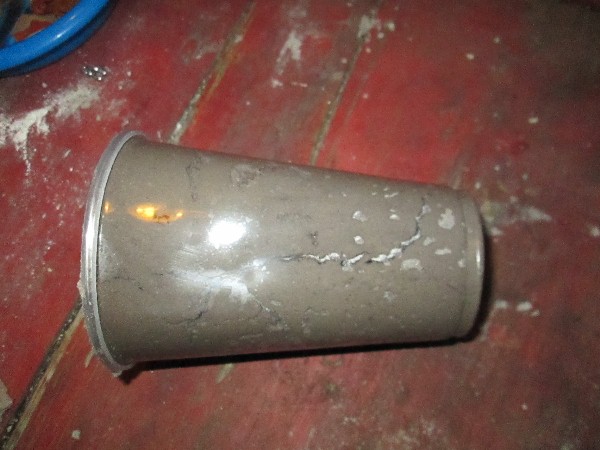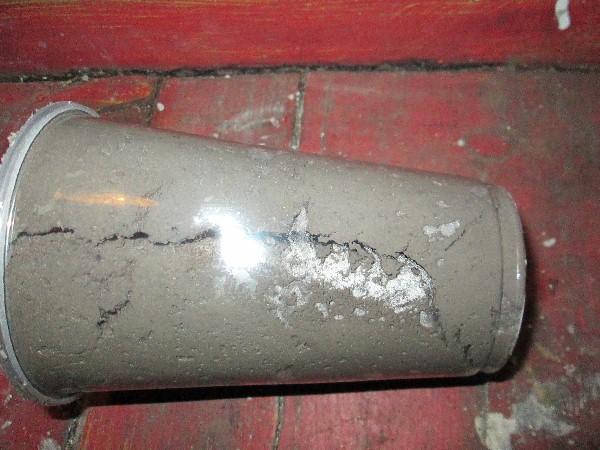Originally posted by Tscarborough
View Post
X
-
Re: 3:1:1:1
But it's the in between parts that you can do beautiful things with the stuff. Free and abundant, it's a god given substance.
-
Re: 3:1:1:1
The strong points of clays are generally when they are wet (sealing reservoirs) or kilned (brick). In between they are unstable, and subject to large swings in volume.
Leave a comment:
-
Re: 3:1:1:1
As clay is composed of decomposed rock, millions of years old, it is essentially superfine sand (an aggregate) but because the particles are so fine they attract one another. This is what gives the clay it's strength, but it is still only a mechanical bond. It hasn't changed chemically (like cement or lime) until it gets fired (over 573 C) I think the moisture protection thing is not too much of a problem. Clay with quite a high moisture content is still as strong as fully dried clay. In some cases I think it is actually stronger. Try smashing a block of partially dried clay compared to a fully dried one. Clay is also used to line dams to create a waterproof layer to hold the water in. Pretty versatile stuff.Originally posted by wotavidoneExactly - no cement, no lime = very lean to me, because I don't see clay as a permanent binder unless you can get it hot enough to "fire". Until then its a reversible thing that must be protected from moisture, etc.
Leave a comment:
-
Re: 3:1:1:1
Permanence is ambiguous with natural products. The way clay is used effects how it performs...and what the final result is. Understanding how natural products work and the way to use them is the challenge.Originally posted by wotavidoneExactly - no cement, no lime = very lean to me, because I don't see clay as a permanent binder unless you can get it hot enough to "fire". Until then its a reversible thing that must be protected from moisture, etc.
But that's fine, see it the way you want.Last edited by stonecutter; 03-19-2013, 08:04 PM.
Leave a comment:
-
Re: 3:1:1:1
Most of the ones I have met do. One reason you see severe degradation in new and 'restored' stonework.Originally posted by Tscarborough View PostMost architects and nearly all engineers specify mortar too strong for the units being laid...
Leave a comment:
-
Re: 3:1:1:1
Most architects and nearly all engineers specify mortar too strong for the units being laid. One thing I will give to our Southern brothers who dominate the rock laying trade here in Texas is that they do understand what mortar to lay with a particular stone.
Leave a comment:
-
Re: 3:1:1:1
Yet it works, same brew as under floor bedding. In a modular oven you are not trying to hold bricks together, but providing a joint where movement can take place if needed. Better for it to crack there where it's designed to rather than where it's not.
Leave a comment:
-
Re: 3:1:1:1
Lean doesn't refer to how many ingredients are in a mix but to the ratio of binders to aggregates that are used in the design.Originally posted by wotavidoneThat's just clay and sand, no cement or lime. The ultimate in "lean". No good at all.
No good at all.
Leave a comment:
-
Re: 3:1:1:1
I think using/making mortar that is too strong is in the top 3 mistakes people make when building. Heck, most masons don't even pay attention to or understand proper mix design.Originally posted by david s View PostTS, yes I agree. The oven I was referring to was built about four years ago. I no longer use the 50/50 clay, sand mix because there is too much shrinkage. I now use a much weaker mix of sand, clay and lime, which performs much better. However I was extremely surprised to see that the oven came out unscathed. I think because the mortar was well compacted and there was no abrasion on it that it survived immersion.
Stonecutter, yes it was salt water and there was no obvious sign of efflorescence.
I would image that if it did show efflorescence, it wouldn't last long anyway.
Leave a comment:
-
Re: 3:1:1:1
Wow, and that's at 3:1 right? Another example of when sometimes leaner is better.
Leave a comment:
-
Re: 3:1:1:1
TS, yes I agree. The oven I was referring to was built about four years ago. I no longer use the 50/50 clay, sand mix because there is too much shrinkage. I now use a much weaker mix of sand, clay and lime, which performs much better. However I was extremely surprised to see that the oven came out unscathed. I think because the mortar was well compacted and there was no abrasion on it that it survived immersion.
Stonecutter, yes it was salt water and there was no obvious sign of efflorescence.
Leave a comment:
-
Re: 3:1:1:1
Here is going to be your main issue with using fireclay and sand alone. It is cracked completely in half plus other small shrinkage cracks, and that is in a plastic cup which retards moisture loss. It does not have enough tensile strength to withstand the amount of shrinkage between wet and damp states, much less dry.


- Likes 1
Leave a comment:
-
Re: 3:1:1:1
Was it salt water that the oven was immersed in? I am wondering about efflorescence. That must have been one heck of a storm!Originally posted by david s View PostThanks, frankly I was amazed. It hadn't even budged the flue pipe. Their house was on the beach and they had a pool table on the same level as the oven in their rumpus room. All the furniture, fridge and freezer were swept about 300 metres inland but the pool table hadn't budged. But on closer inspection found it had done a neat 180 pirouette, or maybe spun around about six and a half times.
Leave a comment:
-
Re: 3:1:1:1
Thanks, frankly I was amazed. It hadn't even budged the flue pipe. Their house was on the beach and they had a pool table on the same level as the oven in their rumpus room. All the furniture, fridge and freezer were swept about 300 metres inland but the pool table hadn't budged. But on closer inspection found it had done a neat 180 pirouette, or maybe spun around about six and a half times.
Leave a comment:
-
Re: 3:1:1:1
Yikes. Well, it must have been a nicely built oven to survive that.Originally posted by david s View PostYes that's true. I told the pottery story to illustrate a point about clay not undergoing change in state from ambient to 500C Actually a modular oven that I built was subjected to a cyclone and was completely flooded. The whole thing was totally underwater from the tidal surge. After drying out it fired perfectly well and there was no erosion of the refractory mortar which was simply a mix of 50/50 sand, fireclay.
Leave a comment:





Leave a comment: